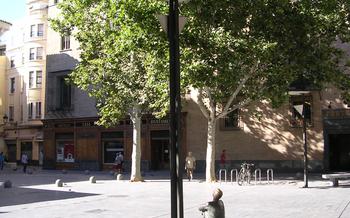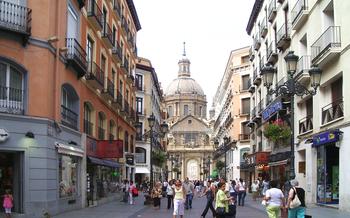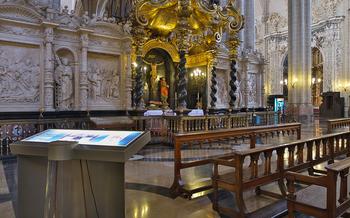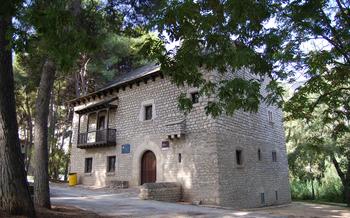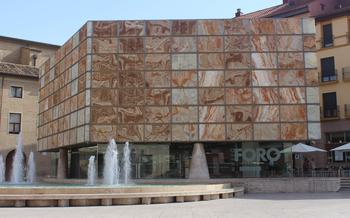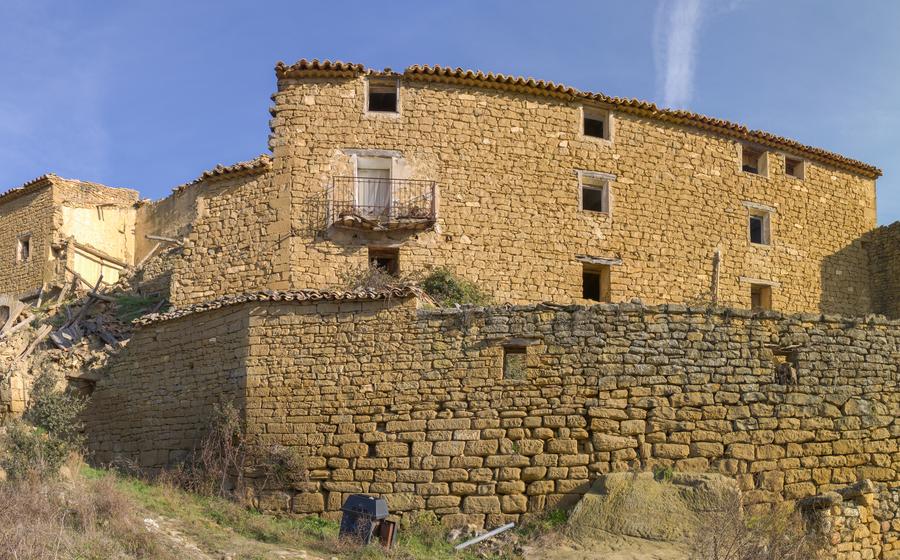
Antiguo Convento de San Agustín
- The Rebirth of an Ancient Monastery: Unveiling the Antiguo Convento de San Agustín
- Navigating the Maze of History: Exploring the Museum of Zaragoza
- From Royality to Renaissance: The Tapestry Hall (Sala de los Tap a treasure trove of Flemish tapestries awaits discovery in the Sala de los Tapices. Step into this grand hall and be captivated by the exquisite tapestries adorning its walls, each a masterpiece woven with intricate detail and vibrant colors. These magnificent tapestries, dating back to the 16th century, depict scenes from the life of King Charles V, the Holy Roman Emperor.
- Unveiling the Secrets of the Roman Theater: A Journey to the Past
- A Journey Through Time: The Medieval Cloister (Claustro Medieval)
- The Art of Healing: Exploring the Pharmacy Museum
- The Enduring Legacy of Goya: A Master's Touch
- A Glimpse into Monastic Life: The Monks' Refectory (Refectorio de los Monjes)
- Unveiling Archaeological Treasures: The Courtyard of Cistercians (Patio de los Cistercienses)
- Tracing the Footsteps of Faith: The Church of San Agustín
- A Tapestry of Cultures: The Mudejar Tower (Torre Mud stands a testament to the rich cultural fusion that shaped Zaragoza – the Mudejar Tower. This architectural masterpiece seamlessly blends Islamic and Christian elements, creating a structure of breathtaking beauty and profound historical significance. Built in the 13th century, the tower served as a minaret for the neighboring mosque during the Islamic rule. Its octagonal base and intricate brickwork showcase the influence of Moorish architecture, while the upper section features Gothic arches and Christian iconography, reflecting the transition to Christian rule. The Mudejar Tower stands as a symbol of coexistence and cultural exchange, a reminder of the diverse heritage that shaped Zaragoza’s identity.
- A Sanctuary of Art: The Chapterhouse (Sala Capitular)
- The Serenity of the Gardens: A Peaceful Retreat
- Interactive Experiences: Engaging with History
- Insider Tip: Unveiling Hidden Gems
The Rebirth of an Ancient Monastery: Unveiling the Antiguo Convento de San Agustín
In the heart of Zaragoza, nestled amidst the bustling streets, stands a remarkable architectural gem that has undergone a remarkable transformation – the Antiguo Convento de San Agustín. Once a hallowed sanctuary for Augustinian friars, this former convent has been meticulously restored and now serves as a vibrant cultural center, inviting visitors to embark on a journey through history, art, and spirituality.
Step through the ancient gates and prepare to be captivated by the architectural details that whisper tales of a bygone era. Admire the intricate carvings adorning the facade, each one a testament to the skill and devotion of the artisans who labored to create this sacred space. As you wander through the cloisters, feel the weight of history in the air, imagining the monks who once walked these same paths, their footsteps echoing through the centuries.
Today, the Antiguo Convento de San Agustín has been transformed into a dynamic cultural hub, hosting a diverse array of exhibitions and events that breathe new life into its venerable walls. Immerse yourself in the latest contemporary art installations, attend thought-provoking lectures, or revel in the melodies of classical concerts. The Antiguo Convento de San Agustín is a living testament to the enduring power of culture, where history and modernity intertwine to create a truly unique and unforgettable experience.
Navigating the Maze of History: Exploring the Museum of Zaragoza
The Museum of Zaragoza, housed within the walls of the Antiguo Convento de San Agustín, is a treasure trove of artifacts and artworks that narrate the rich history of the city and the region of Aragon. Its diverse collections span various eras, from ancient Roman settlements to Islamic rule and the Middle Ages.
Among the museum's highlights are the Roman mosaics, intricate Islamic ceramics, and medieval manuscripts. The Goya collection, featuring some of the artist's most renowned works, is a particular draw for art enthusiasts. Temporary exhibitions, often showcasing contemporary art or specific historical themes, add a dynamic element to the museum's offerings, ensuring a fresh and engaging experience with each visit.
From Royality to Renaissance: The Tapestry Hall (Sala de los Tap a treasure trove of Flemish tapestries awaits discovery in the Sala de los Tapices. Step into this grand hall and be captivated by the exquisite tapestries adorning its walls, each a masterpiece woven with intricate detail and vibrant colors. These magnificent tapestries, dating back to the 16th century, depict scenes from the life of King Charles V, the Holy Roman Emperor.
Woven with the finest threads, these tapestries are not merely decorative pieces; they are a testament to the artistry and symbolism of the Renaissance era. Each tapestry tells a story, capturing significant moments in the life of the monarch, from his childhood to his triumphs on the battlefield. The vivid colors and lifelike figures transport visitors to a bygone era, offering a glimpse into the grandeur and opulence of the royal court.
Beyond their artistic value, these tapestries played a significant role in royal ceremonies and celebrations. They were displayed on special occasions, adding to the splendor and festive atmosphere of these events. The tapestries served as a visual representation of the king's power and authority, reinforcing his status as a ruler of vast domains.
Today, these priceless tapestries are meticulously preserved and displayed in the Tapestry Hall, allowing visitors to admire their beauty and historical significance. Conservation efforts have been undertaken to ensure that these delicate works of art can be enjoyed by generations to come. As you gaze upon these magnificent tapestries, let your imagination soar and be transported back to the opulent world of Renaissance royalty.
Unveiling the Secrets of the Roman Theater: A Journey to the Past
Beneath the vibrant city of Zaragoza lies a hidden treasure—the ruins of a Roman theater, uncovered during excavations in the 1970s. This remarkable discovery offers a glimpse into the lives and entertainment of ancient Romans, transporting visitors back to a time of gladiatorial contests and theatrical performances.
Unveiling the Architectural Marvels:
As you enter the Roman theater, you'll be awestruck by its size and grandeur. Built during the 1st century AD, the theater could accommodate up to 6,000 spectators, making it one of the largest in the Roman Empire. Admire the well-preserved seating tiers, rising in concentric semicircles, and the impressive stage building, which once housed elaborate sets and machinery.
Engineering Ingenuity:
The Roman theater showcases the engineering prowess of the ancient world. Its construction involved meticulous attention to acoustics, ensuring that even the faintest whisper from the stage could be heard throughout the auditorium. The theater's drainage system, with its intricate network of channels and tunnels, effectively managed rainwater to prevent flooding.
Insights into Ancient Roman Life:
Imagine the bustling crowds filling the theater, eager to witness gladiatorial battles, theatrical performances, and religious ceremonies. The theater served as a hub of entertainment and social interaction, reflecting the vibrant culture of Roman Zaragoza.
Ongoing Discoveries:
Archaeologists continue to excavate and study the Roman theater, uncovering new artifacts and insights into its history. Recent discoveries include mosaic floors, decorative elements, and fragments of pottery, offering tantalizing clues about the theater's past.
A Journey Through Time:
Visiting the Roman theater is a journey through time, allowing you to connect with the ancient world and experience the grandeur of Roman entertainment. As you explore the ruins, let your imagination transport you back to a time when gladiators fought for glory, actors brought stories to life, and the city of Zaragoza echoed with the sounds of ancient Roman life.
A Journey Through Time: The Medieval Cloister (Claustro Medieval)
Step into the serene embrace of the Medieval Cloister, a tranquil oasis within the bustling city. This architectural masterpiece, dating back to the 14th century, transports visitors to a bygone era, where time seems to stand still. Its graceful arches, intricate carvings, and delicate tracery create an atmosphere of ethereal beauty.
As you wander through the cloister's arcaded walkways, let your gaze wander over the intricate details that adorn every corner. Each capital tells a story, each motif holds a hidden meaning. The cloister's walls are a testament to the skill and artistry of medieval craftsmen, who poured their hearts and souls into every stone.
In the center of the cloister, a tranquil garden invites contemplation and reflection. The gentle rustle of leaves and the sweet fragrance of flowers create a sensory experience that soothes the soul. This serene space was once the heart of the monastery, where monks would gather to pray, meditate, and find solace.
Over the centuries, the cloister has witnessed countless moments of devotion, contemplation, and fellowship. It has seen the changing seasons, the rise and fall of empires, and the ebb and flow of human history. Yet, through it all, the cloister has remained a sanctuary of peace and tranquility, a reminder of the enduring power of faith and the beauty of human creation.
The Art of Healing: Exploring the Pharmacy Museum
The Antiguo Convento de San Agustín houses a fascinating Pharmacy Museum, providing a glimpse into the history of medicine and its deep connection to the convent's past. Through interactive displays and captivating exhibits, visitors can delve into the world of ancient medical practices and remedies. Marvel at the collection of antique medical tools and equipment, including intricate scales, mortars and pestles, and gleaming surgical instruments.
The museum sheds light on the role of monks as healers and pharmacists, who played a crucial part in medieval healthcare. Visitors can learn about the cultivation and preparation of medicinal plants, the creation of herbal remedies, and the development of early pharmaceutical techniques. The museum also highlights the evolution of medical practices from the Middle Ages to the present day, showcasing how scientific advancements have transformed the field of medicine.
The Enduring Legacy of Goya: A Master's Touch
Zaragoza holds a special place in the artistic journey of Francisco Goya, one of Spain's most renowned painters. The city was Goya's birthplace and where he spent his formative years, leaving an indelible mark on his artistic style and vision. The Antiguo Convento de San Agustín proudly houses several significant artworks by Goya, offering visitors a glimpse into the genius of this master painter.
Among the highlights of the Goya collection is the painting "Crucifixion," a powerful depiction of Christ's suffering on the cross. The emotional intensity and dramatic lighting showcase Goya's unique ability to convey human emotion through his art. Another notable work is "The Annunciation," which portrays the moment when the angel Gabriel appeared to Mary to announce the birth of Jesus. Goya's innovative use of light and shadow creates a sense of mystery and awe in this captivating work.
Goya's influence on subsequent generations of artists is evident in the museum's collection. Works by other Spanish masters, such as Pablo Picasso and Salvador Dalí, reveal the profound impact of Goya's style and techniques. The museum's ongoing efforts to conserve and celebrate Goya's legacy ensure that his artistic brilliance continues to inspire and captivate audiences worldwide.
A Glimpse into Monastic Life: The Monks' Refectory (Refectorio de los Monjes)
Step into the Monks' Refectory, a room steeped in history and tradition, where the Augustinian monks once gathered for their daily meals. The architectural features of the refectory, with its vaulted ceiling, stone walls, and arched windows, create a solemn and communal atmosphere.
In this sacred space, the monks observed strict rules and rituals surrounding their meals. Silence was maintained to foster contemplation and reflection during dining. The monks sat at long tables, facing each other, with the prior or abbot presiding at the head of the table. A simple and frugal diet, consisting of bread, vegetables, and fish, sustained the monks and reminded them of their vows of poverty and humility.
The refectory was not merely a place for nourishment but also a gathering space where the monks came together to strengthen their bonds of brotherhood. It served as a venue for reading aloud from religious texts, sharing news and updates, and discussing matters pertaining to the monastery's administration.
Over the centuries, the refectory's use has evolved. Today, it stands as a testament to the daily lives of the Augustinian monks and offers visitors a glimpse into their world of devotion, discipline, and community.
Unveiling Archaeological Treasures: The Courtyard of Cistercians (Patio de los Cistercienses)
Beneath the surface of the Antiguo Convento de San Agustín lies a hidden world of archaeological wonders, waiting to be unearthed. The Courtyard of Cistercians, once a tranquil space for monastic contemplation, now serves as a window into Zaragoza's rich past.
Excavations in the courtyard have revealed a treasure trove of Roman and medieval remains, offering glimpses into the city's diverse history. From ancient foundations to intricate mosaics, each discovery sheds new light on the lives of those who inhabited this site centuries ago.
The courtyard's archaeological treasures are not merely displayed as artifacts; they are integrated into the museum's exhibits, creating a dynamic and immersive experience for visitors. Through interactive displays and multimedia presentations, the courtyard brings history to life, allowing visitors to connect with the past in a tangible way.
Ongoing research and conservation efforts ensure that the Courtyard of Cistercians remains a vibrant and evolving space, where new discoveries are constantly being made. As archaeologists continue to uncover the secrets of this ancient site, visitors can witness firsthand the thrill of historical exploration and gain a deeper appreciation for Zaragoza's enduring heritage.
Tracing the Footsteps of Faith: The Church of San Agustín
Within the confines of the Antiguo Convento de San Agustín, the Church of San Agustín stands as a testament to the enduring legacy of faith. Constructed in the 14th century, the church boasts a rich history that mirrors the evolution of religious architecture in Zaragoza. Its Gothic origins are evident in the pointed arches and ribbed vaults that adorn the interior, while Renaissance influences can be seen in the elegant ornamentation and elaborate altarpieces.
The church served as the spiritual heart of the Augustinian monastery, providing a sacred space for prayer, contemplation, and religious ceremonies. Its interior is adorned with stunning frescoes and paintings that depict scenes from the life of Jesus Christ and the saints, creating a visually captivating atmosphere. The intricate carvings and sculptures that embellish the walls and altars add to the church's grandeur, showcasing the artistry and devotion of its creators.
For the Augustinian monks, the Church of San Agustín was not merely a place of worship but also a symbol of their faith and dedication. It was here that they gathered for daily masses, held religious processions, and sought solace in prayer. The church's serene ambiance and sacred atmosphere fostered a deep connection between the monks and their spiritual beliefs.
Today, the Church of San Agustín remains an active place of worship, welcoming visitors from all backgrounds to experience its historical significance and spiritual essence. Whether you're a history buff, an art enthusiast, or simply seeking a moment of tranquility, the Church of San Agustín offers a glimpse into the rich religious heritage of Zaragoza and the enduring power of faith.
**A Tapestry of Cultures: The Mudejar Tower (Torre Mud stands a testament to the rich cultural fusion that shaped Zaragoza – the Mudejar Tower. This architectural masterpiece seamlessly blends Islamic and Christian elements, creating a structure of breathtaking beauty and profound historical significance. Built in the 13th century, the tower served as a minaret for the neighboring mosque during the Islamic rule. Its octagonal base and intricate brickwork showcase the influence of Moorish architecture, while the upper section features Gothic arches and Christian iconography, reflecting the transition to Christian rule. The Mudejar Tower stands as a symbol of coexistence and cultural exchange, a reminder of the diverse heritage that shaped Zaragoza’s identity.
A Sanctuary of Art: The Chapterhouse (Sala Capitular)
The chapterhouse, also known as the Sala Capitular, is a remarkable architectural gem within the Antiguo Convento de San Agustín. Constructed in the 16th century, this majestic chamber served as a meeting place for the Augustinian monks to discuss important matters and make decisions regarding the monastery's governance.
The chapterhouse boasts stunning frescoes and paintings that adorn its walls and ceiling. These intricate artworks depict biblical scenes, religious figures, and allegorical representations of virtues and vices. The vivid colors and expressive brushstrokes create a captivating visual feast that transports visitors back in time.
Beyond its artistic splendor, the chapterhouse holds significant historical value. It was here that the monks gathered to deliberate on matters of faith, discipline, and the daily operation of the monastery. The chapterhouse thus served as a central hub for decision-making and spiritual guidance within the Augustinian community.
Over the centuries, the chapterhouse has undergone various transformations, adapting to changing needs and circumstances. While its original purpose as a meeting space remains intact, it has also been utilized for exhibitions, concerts, and other cultural events. Today, it stands as a testament to the enduring legacy of the Augustinian Order and the enduring power of art and faith.
The Serenity of the Gardens: A Peaceful Retreat
Amidst the historical treasures of the Antiguo Convento de San Agustín, visitors can find solace and tranquility in the beautifully landscaped gardens. Designed to complement the architectural grandeur of the former monastery, the gardens offer a serene oasis where one can escape the hustle and bustle of city life.
Strolling along the winding paths, visitors are greeted by a vibrant tapestry of colors and textures. Carefully manicured flower beds showcase a diverse array of blooms, from delicate roses to vibrant bougainvilleas. The air is filled with the sweet fragrance of jasmine and lavender, creating a sensory experience that transports visitors to a world of tranquility.
The gardens are not merely a visual delight but also a place for contemplation and relaxation. Secluded benches nestled amidst lush greenery invite visitors to pause and reflect on the rich history of the site. The gentle sound of water trickling from a nearby fountain adds to the serene ambiance, creating a space conducive to inner peace and mindfulness.
The gardens also serve as a living testament to the harmonious relationship between nature and architecture. The careful integration of plants and flowers into the overall design of the museum showcases the architects' appreciation for the beauty and tranquility of the natural world.
Whether seeking a moment of respite from the museum's exhibits or simply looking for a peaceful retreat in the heart of Zaragoza, the gardens of the Antiguo Convento de San Agustín offer a sanctuary of serenity and beauty.
Interactive Experiences: Engaging with History
The Museo de Zaragoza embraces interactive technology to bridge the gap between the past and present, creating a captivating and engaging experience for visitors of all ages. Multimedia exhibits and interactive displays are scattered throughout the museum, allowing visitors to delve deeper into the history and significance of the artifacts on display.
Virtual reality experiences transport visitors to ancient Roman theaters, medieval cloisters, and the bustling streets of Zaragoza in centuries past. These immersive experiences bring history to life, enabling visitors to feel as if they are stepping back in time.
Educational programs and workshops are regularly organized to cater to visitors of all ages. Children can participate in hands-on activities that spark their curiosity and ignite their passion for history. Meanwhile, adults can attend lectures, workshops, and seminars that delve into specific aspects of the museum's collection or the history of Zaragoza.
Through the use of cutting-edge technology, the Museo de Zaragoza enhances the museum experience, making history accessible, interactive, and enjoyable for all visitors.
Insider Tip: Unveiling Hidden Gems
Beyond the main attractions of the Antiguo Convento de San Agustín, there are hidden gems waiting to be discovered by curious visitors. Explore the secret passageways that lead to secluded chambers and uncover the stories they hold. Join special events and guided tours that offer unique insights into the history and significance of the convent. These exclusive experiences provide a deeper understanding and appreciation for the site.
To fully immerse yourself in the tranquility of the museum, plan your visit during off-peak hours or on weekdays to avoid the crowds. This will allow you to wander through the galleries and courtyards at a leisurely pace, soaking in the atmosphere and absorbing the richness of the exhibits.
After your exploration, take a break at one of the charming local restaurants or cafes nearby. Savor the flavors of traditional Aragonese cuisine while enjoying the vibrant atmosphere of Zaragoza's culinary scene. These culinary experiences will complement your visit to the Antiguo Convento de San Agustín, offering a well-rounded cultural immersion.

